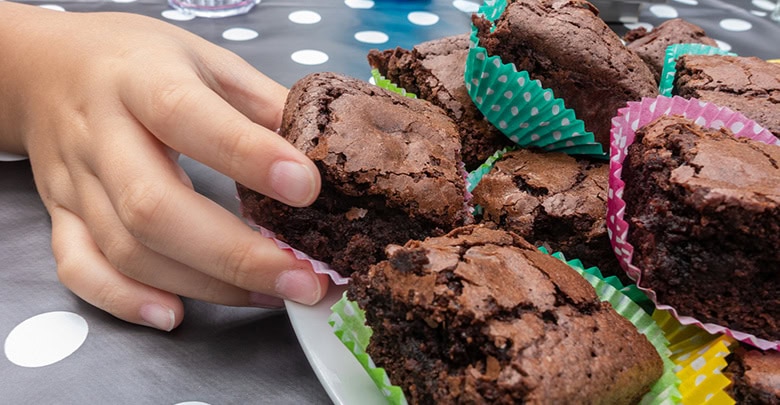Timing Your Highest-Carb Meals to Make Blood Sugar Management Easier
Managing your blood sugar is difficult but getting into a pattern of when you eat your big carb meals can reduce variables and avoid feeling deprived

To live a life without any carbs may work for some, but if it doesn’t work for you…that’s okay.
If the idea of completely giving up bread or apples or brownies doesn’t appeal to you, there’s still a middle ground that can help you adjust your nutrition for the sake of improved blood sugars without total deprivation.
And a big part of that middle ground comes down to being very thoughtful about when you eat those carbohydrates.
Let’s take a look at how you manage the timing of your higher-carb meals to improve your blood sugars and avoid feelings of deprivation!
Focus your carbs into 2 or 3 meals per day
There’s a big difference when it comes to simplifying blood sugar management between eating 150 grams of carbs spread throughout the entire day versus choosing two meals of the day to include your favorite carbs and striving to make the other meals lower in carbs.
In fact, by doing so, you might even find it easier to eat 100 grams of carbs instead of 150 grams.
It’s a lot easier to enjoy a low-carb meal for breakfast and lunch if you know that you’ll get to eat your favorite bread with butter at dinner.
Example #1:
- Breakfast: flax muffin in a mug
- Lunch: grilled chicken on a big salad, dressing on the side
- Snack: nuts, apple, carrots
- Dinner: steak, asparagus, bread, and butter
- Dessert: 1 homemade brownie
- Approximate total net carbs: less than 100 grams
Example #2:
- Breakfast: chicken sausage and a big salad, dressing on the side
- Lunch: tofu on a big bowl of stir-fry veggies and brown rice
- Snack: bell pepper and hummus
- Dinner: portobello mushroom “burger” with mozzarella and tomatoes
- Dessert: ½ pint of low-carb Halo Top ice cream
- Approximate total net carbs: less than 150 grams
Example #3:
- Breakfast: Eggs & Sausage Bagel Sandwich
- Lunch: grilled chicken with greens, chickpeas, strawberries, walnuts
- Snack: veggies and ranch dip
- Dinner: taco salad
- Dessert: favorite local chocolates
- Approximate total net carbs: less than 150 grams
You’ll notice that all of these meals contain some carbs. They are certainly not following the laws of an Atkins or Ketogenic diet. But the higher-carb meals are balanced by lower-carb meals.
By targeting your carbs into certain meals rather than spreading them across all of your meals, you’re ensuring that about half of your meals each day are indeed very low-carb.
This means that half of those meals are easier to manage your blood sugar around, require less insulin, and add fewer blood sugar variables to those hours of the day.
It’s also motivating to eat a low-carb breakfast, for example, if you know that you’ll get to enjoy a higher-carb meal you really love at dinner.
Choose the carbs that matter to you most, and make other meals as low-carb as possible with a focus on whole foods and lots of vegetables.
Establish long-term sustainability in your relationship with carbs
In an ideal world, sure, we’d all easily resist homemade cookies, the perfectly crisp baguette, and your grandmother’s 100-year old lasagna recipe.
If restricting your carbs to “less than 50 grams per day” or even “less than 100 grams per day” leads to binge-eating tons of carbs a few days or a week from now, then that isn’t a sustainable approach.
The common consequence of “failing” in a strict low-carb diet is to tell yourself that you simply need to try harder and be more disciplined, and try to follow that strict low-carb diet again. This can easily lead to an abusive relationship with food, a cycle of binge-eating and restricting, followed by a lot of guilt, shame, and frustration.
This pattern of low carb/high carb eating can go on for years if you don’t acknowledge it and nip it in the bud.
Instead of getting sucked into this rollercoaster relationship with food, think about a sustainable relationship with carbohydrates that is right for you.
Clue #1: You eat (and crave) carbs all day long
Have you ever taken the time to look at how often you eat carbohydrates but also when you crave carbs the most?
If your answer to both questions is all day long, then it’s time for some deeper evaluation.
“Carbs begets carbs,” says Mara Schwartz, RN, CDE and coordinator of the Diabetes Prevention Program at Self Regional Healthcare.
“The more carbs I eat, the more carbs I crave,” explains Schwartz who has lived with type 1 diabetes for most of her life.
Schwartz recommends reducing the lowest quality carbohydrates in your diet — particularly in beverages and processed packaged foods, including crackers, pasta, bread, and baked goods.
- How many times per day are you eating processed carbohydrates?
- How many grams of added sugars are you drinking each day in beverages?
- How many grams of added sugars are you eating each day in food?
Take a few days to honestly think about your current habits around carbohydrates — the processed ones and the whole-food ones.
Carbohydrates are not the devil. They are one of the three macronutrients we find in food, and plenty of them come with wonderful vitamins, minerals, flavors, and fun recipes!
As people with diabetes, we simply need to be more conscious of our carbohydrate consumption if we’re striving to improve our blood sugar levels.